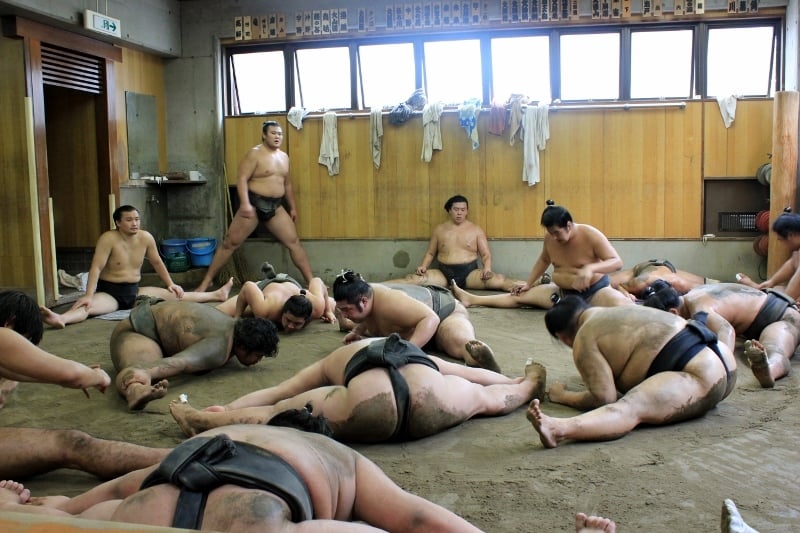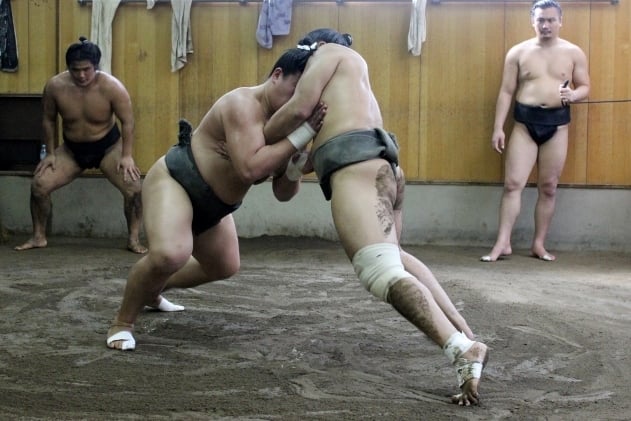We stood outside of a sumo stable in the Ryogoku district of Tokyo, one of the places where wrestlers practice and live, hoping they would allow visitors to watch as they refined their craft. No such luck.
Today was a health check day for the wrestlers and even if they were having practice, most were not accepting visitors.
Though our guide Tomomi had previously confirmed that spectators would be welcome with this particular stable on this day, they must have changed their minds. It happens.
We made a plan to get to a stable early the next morning, as they should all be very healthy by then. Though we could have attempted to roam the streets in search of a stable on our own, I was happy to have Tomomi, from Tokyo Tours with Tomomi, as our guide because at these stables there was some sort of communication that needed to take place in Japanese. That would have been a tiny problem without someone that actually spoke Japanese.
My handful of words, which mostly included versions of ichiban, wasn’t going to cut it.

Plus, she knew just about everything about the sport of sumo and brought informational sheets describing what would be taking place. We would have surely been lost on our own.
A sumo stable practice is not your typical tourist attraction. The athletes are not putting on a show for you, they are in serious training and with a pending tournament closing in they didn’t have time to waste.
There are many rules to abide by if you are going to be watching the action; No flash photography. No leaving before the end of practice. No talking. No moving.
Basically, just shut up, stay still and respect the sport. Easy.
The next day we arrived at Hakkaku stable at 8:00am and were the only spectators at that time, but by 9:00 the viewing platform was almost full. The practice area was small, consisting of the dirt dohyo (ring), a viewing area big enough for about twenty people and a small section filled with free weights.
The practice was a mixture of faux matches, as well as performing ritual flexibility and strength exercises.
The stero-typical body size of a sumo wrestler does exist, but it also varies greatly. There is everything from the round to the trim, all filled with muscle.
You can’t begin to imagine the intensity of this sport unless you are there to witness the panting, grunting and dripping sweat. The training sessions are long and strenuous.

At times one wrestler would compete in several consecutive matches. I am not sure if they were being punished or rewarded.
In the middle of practice, the stable master, and former Yokozuna grand champion, walked in. He was immediately catered to by the junior wrestlers. One brought him a sitting mat while another the newspaper, then several went before him and bowed.
This same sort of hierarchy seemed to be present amongst the wrestlers too.
When the white belt wrestler, and indication of higher rank, got into the ring the junior wrestlers catered to him, handing him a towel to wipe his brow, giving him drinks of water when he beckoned and even icing his pained shoulder. I want a white belt. He was the bad ass of this stable and it was easy to tell why. He could probably flip a car one handed and most of the others were no match for him. But, there was one wrestler half his size who came close.
After his last bout he sat his ginormous body right in front of me, stretching his legs and watching the others practice. Normally I would have been a little peeved about someone blocking my perfect photo op view, but I wasn’t about to tap him on the shoulder to ask him to scooch on over.
I had no intention of being thrown over his shoulder and into that ring.
After the practice bouts, it was time for group stretching. I believe I had done some of these moves in yoga class, without as much flexibility.
It is truly impressive when a massive man can do a seated forward fold and I can’t even touch my toes.

After about two hours, the wrestlers put their hands into a prayer pose, looked up and thanked the gods. I would have been thanking them for actually having survived the last two grueling hours of practice at the sumo stable.
At that point, some of the junior wrestlers were in charge of watering and sweeping the ring. This would be a good incentive to bulk up and not be a junior any more.
As we left the sumo stable, we saw the wrestlers in the alleyway hanging up their belts, chatting amongst each other and washing the dirt off their bodies with just the water from a spray hose. The sense of camaraderie is evident, the battles in the ring forgotten already.
More Details
Many stables that allow visitors will require appointments by phone at least a day in advance and some request a Japanese speaker accompany you. Though you can attempt a visit on your own, it’s much easier with a guide who speaks Japanese; Tokyo Tours with Tomomi (www.tokyotourswithtomomi.weebly.com) escorted me to practice at Hakkaku–beya (1-16-1 Kamezawa, Sumida-ku, Tokyo). But, you can also easily book a tour online at Voyagin.
When navigating on your own you can try the following stables:
- Oshiogawa-beya | tel. +81 (03) 3643-8156 |2-17-7 Kiba, Koto-ku, Tokyo | Subway: Tozai Line to Kiba Station
- Wakamatsu Stable| tel. +81 (03) 5608-3223|3-5-4 Honjo, Sumida-ku, Tokyo| Subway: Toei Asakusa Line to Honjo-Azumabashi Station
- Futagoyama Stable| tel. +81 (03) 3673-7339|8-16-1 Kita Koiwa, Edogawa-ku, Tokyo| Train: Keisi Main Line to Keisei Koiwa Station
- Musashigawa Stable| tel. +81 (03) 3805-6343|4-27-1 Higashi Nippori, Arakawa-ku, Tokyo| Train: Train JR Yamanote Line to Uguisudani Station
- Oshima Stable| 3-5-3 Ryogoku, Sumida-ku, Tokyo | Subway: Sobu Line to Ryogoku Station
- If you want a quick (& free) peek go to Arashio-beya where you can see the action from the windows out front. 2-47-2, Hama-cho Nihonbashi Chuo-ku Tokyo | tel. 81-(03) 3666-7646)
Traveling Soon? Use my Favorite Resources for Booking Your Trip!
Book Your Flight
Expedia is my favorite flight search engine, because it checks dozens of airlines so you can easily find the best fare deals. You can also select ‘Watch Prices’ to get an email alert when the prices change.
Book Your Accommodations
I use both Booking.com and Expedia for hotels, because each offers a couple different hotel choices and I like to compare the reviews on each one. If you have a group or are looking for more of a home atmosphere, head over to VRBO or AirBNB that has houses, apartments and even just a room for rent in every price range.
Book Your Rental Car
If love the freedom to explore like I do, driving from place to place is the best option! I always book with RentalCars.com (it’s part of booking.com) for the best prices and top brand options.
Book Some Fun Tours!
Viator and Get Your Guide are my go-to search engines for cool bucket list experiences! Each one can have different tours, so check both—why limit yourself, right?
Don’t Forget Travel Insurance
Travel can be unpredictable. Whether it’s a last-minute cancellation, an injury, or (ugh) theft, things happen. That’s why I recommend never leaving the country without travel insurance. Here are my faves: Safety Wing and World Nomads.
Get Packing & Travel Essentials Ready
Check out the Bucket List Journey Amazon Store to find all my favorite travel essentials. Everything from Packing cubes, to travel adapters and toiletry containers to walking shoes.
*Lastly, check travel.state.gov for visa requirements and safety information.
More Tokyo Articles
Tokyo Bucket List: 44 Top Things To Do in Japan’s Coolest City
4 of the Best Day Trips from Tokyo
Tokyo Food: 13 Themed (& Slightly Weird) Cafe & Restaurant Experiences
Japanese Culture, Traditions and Customs: 15 Lifestyle Facts to Know
Watch Wrestling Practice at a Sumo Stable in Japan
Captivating Chaos: Tokyo’s Robot Restaurant Show
Visit Tokyo’s Tsukiji Fish Market
Shinjuku Nightlife: A Guide to Tokyo’s Best Golden Gai Bars
Best Quirky Café in Japan? Tokyo’s Calico Cat Café in Shinjuku
Eat at a Themed Restaurant in Tokyo
How to See a Japanese Baseball Game in Tokyo








wow they are super flexible!
Who would have thought, but that is definitely a very unique bucket list experience. I have to keep this in mind while traveling to Japan :)
Wow, that sounds like an awesome experience. Maybe we’ll be lucky enough to witness some training when we’re in that part of the world. Also, he blocked your view but also gave you a nice shot as well =)